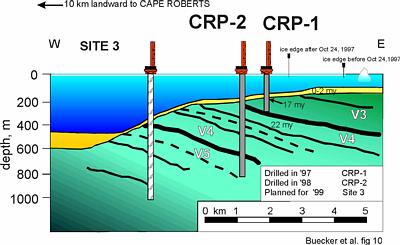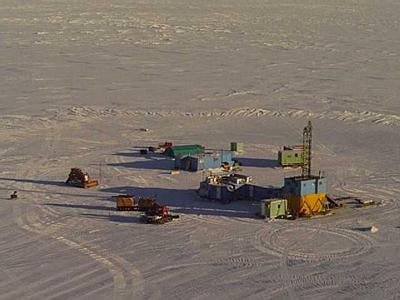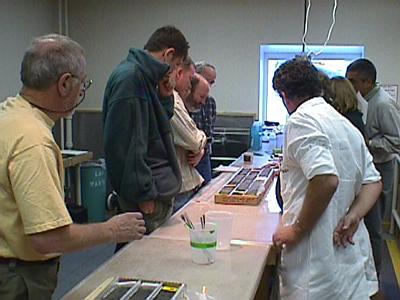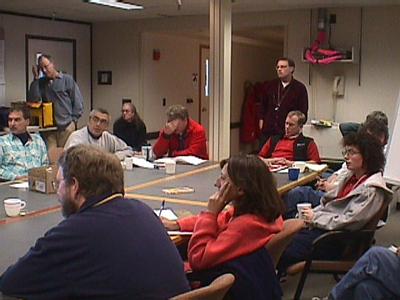
|
|
2 December, 1999
NEWS FLASH: I just got word that I may be on a flight back to New Zealand
tomorrow morning. (Remember, stay loose in Antarctica.) This is still unsure
as the weather here is overcast and the southbound flight from Christchurch
might be cancelled. If I fly tomorrow, this will be my last journal from the
ice. I will post a journal from New Zealand to let you know how the flight
went. If not, I will post one last journal from Antarctica tomorrow. B.S.
The on-ice phase of the Cape Roberts Project is just about over. There was a
get-together, a kind of Bon Voyage party, for the members of the CRP Team at
Scott Base last night. Peter Barrett, Chief Scientist on the project, gave a
short speech summarizing the history and accomplishments of the project.
Yesterday, a science meeting was held in Crary Lab during which each science
group gave an overview of their findings and interpretations of the data to
date. Each scientist has contributed to an Initial Report, which is to be
completed before they leave the ice and will be published soon after.
These are the events that are bringing closure on the most ambitious
drilling project ever in the Antarctic. It has been a three-year project
that has involved hundreds of people from many parts of the world. What were
the results from CRP-3, the last year of drilling? Many of the findings that
can be gleaned from the data collected will not be known for months or years
from now after scientists have had time to analyze the tremendous amount of
data generated by CRP-3. The information must also be compared to the other
years data and information from other sources. However, there are some
conclusive findings that were presented at the summary meeting that tell of
the success of CRP-3. As a reminder, the original science goals of the
project were to answer these two questions: "Did the ice sheet grow and
decay on Antarctica, with attendant changes in global sea level, prior to
the earliest Oligocene 34 Ma ago, when it is widely believed the first
extensive ice formed on the continent?"; and " At what time did the
continent begin to rift to form the Ross Sea and the Transantarctic
Mountains?".
The scientist who proposed the project believed that in order to start to
answer these questions, they needed to study rock deposits from that time
period between the Oligocene geologic epoch (24-34 mya) and the Eocene epoch
(34-55 mya). They determined from seismic studies that the Cape Roberts area
would be a likely place to drill to reach these rocks. They proposed to
drill three holes, each one drilling in rocks overlapping in geologic time
with the previous one in order to produce a continuous rock record of the
time when Antarctica changed from a relatively warmer climate to its present
cold climate, about 34 million years ago. It was hoped that the data from
CRP-3 in 1999 would help unlock the history of this critical time?
The CRP-3 drilling was a great technological success. The drilling
went to a depth of 940 meters, a record for drilling in Antarctica, and went
a long way towards perfecting the task of sea ice drilling in these
difficult conditions. The knowledge gained will greatly benefit future
drilling here and in other ice-covered locations around the world.
Scientifically, a lot has already been learned from the rocks of the drill
cores. The scientists feel that the rocks at the top of CRP-3 may be the
same age as the rocks at the bottom of last years drilling, CRP-2. They
think there is about a 20-meter overlap. They are also confident that the
rocks at the top of the hole are Oligocene in age, about 32 million years
old. This was determined primarily from studying the microfossils found in
the rocks. Below the top 100 meters or so, the number of fossils diminishes
greatly and the age of the rock is harder to determine. They need to wait
for other dating information, paleomagnetic and radiometric data for
instance, in order to date these rocks. They know the age of the rocks is
getting older as they go down the hole, perhaps back to the very start of
the Oligocene, the beginning of the cold period in Antarctica, but are not
sure if they have drilled to the Eocene. The rocks do indicate change in the
climate, however. The rocks from the middle to early Oligocene indicate the
existence of low diversity, beech type vegetation, similar to tundra areas
in Canada and Alaska. The sediments seem to indicate glacial advances and
fluctuations that affected the type and distribution of plants. But did they
get to the Oligocene/Eocene boundary, that critical time in Antarctic
climate history? The consensus is probably not. As they drilled deeper, the
rocks of the Oligocene were getting older and tantalizingly close to the
Eocene. Then they suddenly drilled into rocks that were much older, skipping
over 300 million years of time, to the Devonian period. This was quite
unexpected! No model of the rocks considered by the geologists in the
project predicted these rocks to be here. This was a new finding and forced
the scientist to reconsider their understanding of the geologic history of
the Transantarctic Mountains in this region. Much of the summary meeting and
many casual conversations were consumed with speculating on alternative
models of the formation of the rocks in the area. It will take many years
and probably more drilling and exploration to answer the questions that the
discoveries of CRP-3 has forced the scientist to ask.
So no, CRP-3 did not reach the goal of getting a continuous rock
record of the Oligocene/Eocene boundary. The questions originally posed in
the science plan are still left unanswered. But progress has been made
toward achieving the answers. Perhaps more importantly in the scope of human
scientific understanding, our knowledge of the history of this part of the
Earth has taken a leap forward and CRP-3 has created a entire new set of
problems and questions to be answered. Science could not be better served.

Here is the diagram from the CRP science plan of the three proposed drill locations and the predicted rock structures. They now know the rocks below the Ross Sea are arrange differently than this.

The CRP-3 drilling went to a depth of 940 meters below the sea floor, an Antarctic record.

The study of many boxes of core samples like these has contributed much to our knowledge of the geology of the Ross Sea region.

The scientists spent countless hours comparing and discussing the results they obtained.

The Land of the Midnight Sun! This picture was taken just after midnight on November 26, 1999 at McMurdo Station, Antarctica by Bruce Smith. Awesome!
Contact the TEA in the field at
.
If you cannot connect through your browser, copy the
TEA's e-mail address in the "To:" line of
your favorite e-mail package.
|
